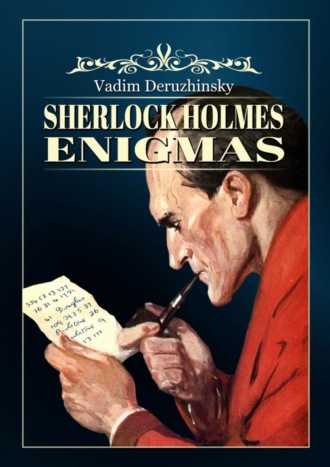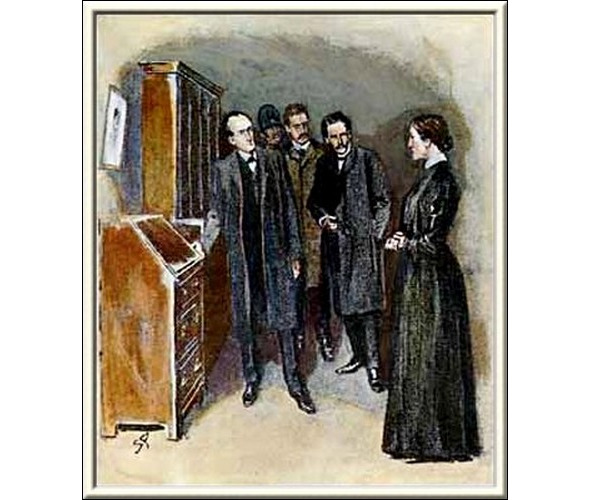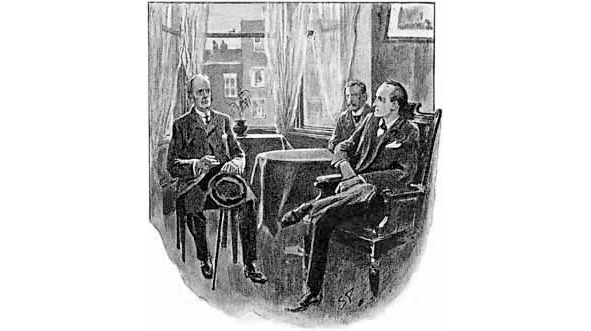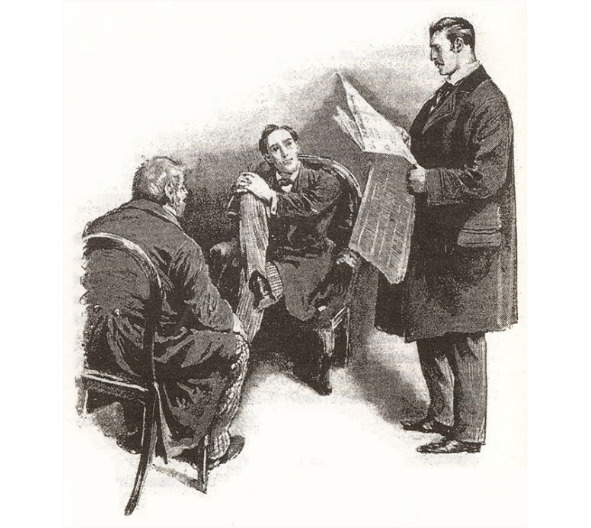
Полная версия
Sherlock Holmes Enigmas
Holmes got closer to the bed, touched the Brown’s hand. The major was really dead.
“What’s happened?” he asked, turning to Adams.
“Brown was sick,” the doctor began to explain, gathering his instruments into his bag. “A month ago he addressed to recover a very strange illness. Some Indian wizard cursed him. The wizard whispered that Brown would die while sleeping because of the awful dream. When Brown returned back from India he began to suffer from nightmares, he had seen the wizard who moved out from the darkness and stretched his long – about several feet – hands to him. And then Brown awaked.”
“Well,” said Holmes, looking at the dead face of Brown. “They say it is mystic. But I would better to say of hypnotizing. Well, please continue.”
“There is nothing to continue,” answered Adams. “We have come to this house, nightmare disappeared… But some days ago these awful dreams came back. Last morning Brown told me about another nightmare. Indian temple. Snakes on the walls, poison green smoke out of the windows… And an awful voice of the wizard… Then this damned old man came out to the major and caught his throat by his curling nails… Brown then could not sleep until the light.
Afternoon I made Brown to sleep for an hour upon my control. He slept not well. The wizard came again, but that time he appeared from the great hole of the black tree. He stretched his fingers to him. Each finger was a scorpion.
Brown shouted and got up. He was in cold sweat. Last night the wizard looked like dead man with worms on his face, with empty eyes holes, and a big knife in the hand. He said “I came to murder you’.”
Adams stopped his tale, a policeman and a police doctor came in. Then Adams continued:
“This is simple and dramatic circumstances that took place. In the moment I slightly touched his neck by two fingers to test his pulse Brown saw the wizard in the shape of a great snake hitting his neck by two teeth as. And his heart did not stand it. A sheer heart attack happened. His face turned red, he opened his eyes and tried to get up from the bed, but fell down… I called Mrs. Carry. We tried to recover Brown, but useless. The wizard said he would die. Alas! That happened…”
Suddenly Holmes loudly said:
“But Sherlock Holmes from London is saying that you are liar and would be arrested. Constable! Arrest this man!”
I was puzzled. Holmes again saw something that I did not. What?
ANSWER:
“My friend! It is so easy!” Holmes laughed, getting out his pipe.
“Please don’t! I want to know what have you got this time! Adams looks a good man! How did you see that he was telling not truth?”
Holmes smiled.
“It’s so easy! How could Adams know what did Brown see before his death? May be he is not a killer, but he is a liar at least… Darkness!” Holmes knocked his forehead and turned back to me. “This his word sounded strange also…”
In two weeks, in London, we received the letter from Scotland Yard. The Scottish police thanked us for the help. They informed that Adams was hunting for rich men’s priorities. He was not a medicine doctor at all! Adams decided to fool Brown using his specific psycho disease. This bustard gave to former major hallucination pills which caused nightmares. Then he poised Brown. If not Holmes Adams could fool Scotland Yard as well. Frankly speaking, as Holmes said to me secretly, in this case he was risking. The story about the last nightmare any doctor could just propose as a version. But Holmes’ deduction did not let him down.
5. Incident in the Museum

“In works of art, frankly speaking, I’m attracted to not their artistic merits. I’m attracted to their criminal history. I look at them as a subject around which con artists and thieves always commit their crimes. Agree, it is not less interesting aspect of the artwork, you may say, its second life and the second story. Now, Watson, can you tell me about this pretty thing?”
Holmes pointed at a golden medallion with a large diamond hanging behind glass on the Museum wall… We were spending that evening at London’s Museum of Fine Arts as according to inspector Lestrade’s information, in the night there was supposed to be a robbery over there. The police knew that a robbery will certainly happen this night (agent Lestrade heard about this at the meeting in the thieves’ environment), but no one knew exactly who would be a robber. The inspector did not rule out that it may be a good skilled recidivist, that’s why he invited to the Museum Holmes, who knew with photographic accuracy the faces of hundreds of dangerous criminals.
“Oh, this is the famous locket Messalina!” I exclaimed. “In 1701 it was made by the Italian master Casacci. Then it belonged to the Pope, then uh… someone else. And was donated to the Museum by Lord Verrington.”
I expected that my extensive knowledge will make an impression on Holmes. But Holmes looked disappointed.
“You see, my friend,” sadly he said. “It turns out you know nothing. This medallion was stolen 27 times, 8 times they sold its fake copy, eleven people were killed in the struggle for the possession of it, three of them were strangled, one drowned, four poisoned, two stabbed and one was killed by a fireplace stick. I can tell you all the details of each case. That’s what I name by a phrase ‘to know something about things’…”
I didn’t have time to answer Holmes because suddenly out of the dark halls of the long Museum corridors a police whistle sounded and a woman screaming for help. It was certainly one of the Museum caretaker who called the police: all of caretakers had police whistles to signal in urgent cases.
“Quick, Watson!” cried out Holmes. “The robbery occurred!”
I hurried up after him…
A woman of about forty-five, the curator of the Museum, looked worried and confused. A green lantern shining from the street through the assembled from colored glass window painted the woman’s face scared to death. But I thought it was just an illusion. Holmes, inspector Lestrade, me and two policemen listened to the story of the woman.
“I, as Mr. Inspector ordered, was walking from room to room, trying to notice strange and not to frighten anybody who intends to commit theft. I was over there,” she pointed across the corridor to the far room, “when I noticed HIM. He was in this room and very suspiciously stood over by the Faberge eggs table. Then I slowly looked out of the corner… looked carefully… And saw that the glass table is broken, and this man is trying to get the egg. Then I got scared, grabbed a whistle and began to whistle as crazy!”
“Where is this?..” began to ask Lestrade.
“Here it is!” a woman solemnly showed the whistle.
“Not a whistle! A robber!”
“Ran to the exit. He took nothing!”
The inspector sighed in relief.
“Well, we’ll catch him finally. We’ve got him already. All the ways are blocked by the police, he will not go far.”
And he turned to a constable, ordered to detain all the men located at the Museum and bring them here.
“Now we’ll figure him out!” Lestrade joyfully rubbed the palms. “Well, let’s tell me what he looked like?”
“I can’t say that,” the woman shrugged her shoulders. “I had no time to see him.”
Lestrade swore, and Holmes asked:
“But you saw something?”
“But do not worry,” reassured us woman. “It seems to me, I know who he is.”
“Who is he?” surprised Holmes and the inspector at the same time.
“An old soldier.”
“Who?”
“A soldier of Oliver Cromwell time, I tell you. Better say he pretended to be a Cromwell’s soldier. In a grey-green round soldier’s helmet of XVII century.”
We all stood puzzled silently.
“Nonsense!” said Lestrade. “Are you well? Why the helmet? Who goes to the Museum in the helmet of XVII century? Thompson!” then he called a sergeant.
“Has anyone entered the Museum in such an old time helmet?”
“No, sir! There were visitors in hats, but they left hats in the closet.”
“Well! What helmet?”
“He had a helmet on, I’m telling you,” the woman repeated stubbornly. “Iron grey-green helmet. I’ve seen such helmets last year in Stemp street at historical show parade of Cromwell’s troops.”
“Excuse me,” intervened Holmes, “you want to say that he was in the XVII century’s Army uniform?”
“I don’t remember. Did not notice… and there is a bit dark here. Visitors, in fact, have gone already. It is time to close the Museum, as usual, we begin at this time to turn out the light, leaving only emergency light. But the glimmering helmet I saw accurately.”
“Thompson!” turned to the sergeant Lestrade. “Look for the helmet! Fast!”
Meanwhile in the next room, the constables gathered the detainees.
“Well, Mr. Holmes,” said the inspector, who was looking sad, “let’s look at our detainees…”
There were four of them, late visitors of the Museum: Mr. Bull, a retired major, dark haired, with sideburns and with a contemptuous smile, dressed in an expensive blue suit and kid gloves. In the pockets of retired major they found cigars, a lighter, a purse and a gold watch. Then there was a student, Hockins, frightened and frail blond young man with shifty eyes and nervous hands, dressed in an old cloth coat with bulging pockets. Policeman found in his pockets only a notebook, a letter to his mother to Scotland and tweezers.
An artist Jofroi, unshaven Frenchman in a sweater and beret with a striped scarf around the throat, with a small flask of whiskey in the bag, cigarettes, matches, a comb, a set of paints with brushes and an album of sketches from models, and also a mirror, a screwdriver, an alarm clock and a pair of socks.
Lord Transey dressed in the latest fashion, with a bid beard, but completely bald, with a heavy gold chain on an expensive jacket, with a cane of ivory… Constables did not dare to feel up this important gentleman. Especially since Transey looked angry, his big bald head shook nervously.
Sergeant Thompson, withdrawing to one side of the inspector, reported that no any helmets were found.
“Well,” shrugged Lestrade, turning to Holmes. “What would you say?”
I did not let Holmes to answer.
“My dear Inspector,” I said yawning. “Your business is not worth a damn.”
In my mind I congratulated myself for a brilliant deduction line and continued as if lazily:
“I know who did it”.
“Wow!” Lestrade looked at me happily. “And who is he?”
“Be careful, Watson,” said Holmes. “We must not be wrong.”
But at that moment I was sure that there was no any error.
ANSWER:
“It is the major! See how he looked at us! You’ve seen it? It’s not just so! He tried to steal the Faberge egg, I assure you. You will see it for yourself, if just to try to think it over! So he was an officer. Huh? You know? Only he could be fond of the British Army history. He used an old helmet to frighten poor women. And I know that in the next hall they are having a dummy of Cromwell’s soldier!”
“All right,” said Lestrade, after hearing my words. “Where’s your damned helmet then?”
I shrugged my shoulders.
“And why did he have this helmet? Hell, I do not understand anything!” inspector Lestrade waved his hands and began to walk the floor nervously.
Holmes coughed.
“Friends,” said Holmes. “You don’t see the obvious things. No helmets at all! Only an idiot would come up with the idea to take an old Army helmet. In the hall where a robber happened to be, the lantern from the street shines through the colored glass, creating a picture of the execution of Mary Stuart (see, Watson, I know history too). In colors of this glass a green color is dominated, and this color paints all in the Museum hall – especially when they leave only a duty light. You can see it. And a bald head of one of our detainees was taken for a helmet Cromwell’s soldiers, as a green or grey iron helmet. It is no wonder, because it is difficult to imagine a person with the metal gleaming head.”
“How?” gasped Lestrade. “So you want to say that the Lord Transey…”
“Oh!” Holmes shook his index finger. “I didn’t say that. It is you saying this.”
6. The Flowering of the Strange Orchid

“Dr. Thomas Glume died on 15th June, 1881, and died in circumstances that can definitely be called strange…”
Inspector Lestrade paused, sipping brandy from his glass, and gathered his thoughts, trying to remember exactly all the details of the old case.
The three of us sat by the fireplace in our apartment on Baker Street spending the evening reminiscing about the investigations of bygone years. For the most part, however, Lestrade was doing it, Holmes and I listened, and only occasionally Holmes gave their comments.
“If I am not mistaken, Dr. Glume was found dead in his office by his secretary miss Penny. This woman, I tell you, I didn’t like her: she looked prim, haughty, dry, and, I note, there was some cruelty and anger in her. Although she was pretty and looked quite fashionable: painted lips and eyelashes, beautifully dressed, had long painted nails. But it’s a cold, predatory beauty, if you know what I mean. Unlike her Colonel Badham seemed to be friendly and sincere, he was Dr. Glume’s old friend, they lived together for a long time in India. Badham was an old, weak and painful, the man who lost a leg in battles, so he moved using the prosthesis and had always relied on a cane. Since the return of Dr. Glume from India, Badham has lived in the doctor’s house, helping him as much as possible in his work. And finally, there was another character in this drama: the servant Host, who had a typical bandit face and huge fists. I’d never want to meet him alone somewhere in a dark alley. He gave the impression of a calm person, but having a look at his eyes as I immediately realized that kind of fruit. Believe me, I have a lot of experience in this.”
“So,” continued Lestrade, sipping brandy, “Dr. Glume died, as I said, quite strange. Generally speaking, he was a strange man. He had a lot of money – 12 years ago he received a rich inheritance. But at the time of his death, he spent almost all the money on his collection: he collected expensive exotic flowers that were sent to him from around the world. For the most part, these flowers died, not because of English climate. But the doctor was not discouraged and ordered new and even more rare specimens.
About three weeks before his death, they brought to him a rather strange unknown flower from some incredibly distant and wild country. It was Orchid. English botanists considered it was a new unknown in Europe plant. No one in Europe or America has ever seen such a flower. Dr. Glume put the Orchid in his study and admired it for days, waiting for the time of its flowering.
It blossomed the very day he died. The secretary found him dead on the floor near the window, on which this Orchid stood with flowers of strange shape and incredible, unusual beauty.
The Secretary called the doctor and the police. I ran the investigation. I confess that this Orchid had a hypnotic effect on me. I was looking at the flower, and it really scared me. After questioning the tenants, I turned to the Botanical reference books, many of which stood on the bookshelves of the deceased. And I read that, according to the references of travelers who have visited exotic lands, there are species of orchids, the aroma of which causes death.
Then there was a new trouble, which fully confirmed my fears that the death of Dr. Glume is caused by the flower. Coroner Stapleton, as looking at the flower, sniffed it and fell dead! The second body in this house! The Orchid was clearly deadly thing… I say, after the incident, I was afraid to approach the flower closer than three yards. Actually, I’m still afraid of orchids. Yes, Mr. Holmes and Mr. Watson, it may sound silly, but I’m afraid of orchids. If you had two corpses lying in front of your eyes, dead because of smelling flowers, I think you would understand me…”
Inspector Lestrade paused, gazing thoughtfully at the fire, and sipping his brandy.
“Well, well, well,” I said, cause the inspector’s terrible story really scared me. “Can a flower really kill?”
“A very interesting story,” said Holmes from his chair. “So, Inspector, did the Orchid really kill those people?”
“No doubt,” answered Lestrade. “That’s right: the Orchid killed those people…”
“However,” he continued after a moment, pouring himself another brandy from a large decanter, “we need, of course, clarity. Flower is a killer. But it had an accomplice, if I may say so. As you know, Mr. Holmes, I’m an old fox. There were some people who wanted to create the impression that the death was occurred by accident, because of careless handling of a poisonous plant. And I was about to believe it. But, as a careful person and a doubting man (the other on my place would believed it), I sent the flower to research it in Research Department, and began to collect information about the doctor and his three roommates.
As it turned out, all three had reasons to have Dr. Glume dead. The doctor made a will, divided all his stuff between secretary Penny, Colonel Badham, a servant Host and the Botanical Museum of London, where, up to the will, a flowers collection had to go. So, the situation was that Dr. Glume was going to order another 50 such orchids. But it would cost him an astronomical sum of money, the sum that would ruin Dr. Glume immediately after this purchase. He, a fanatical collector, was not afraid of such a fate – it was more important to get the passionately desired orchids. But three of his roommates, assistants and heirs quite clearly understood that in this case there will be no inheritance – they will not receive a penny. So there was a motive for the murder.
By the time I learned all this, the results of the analysis of the flower came. It turned out that the flower was filled with extremely poisonous powder – some cyanide, if I’m not mistaken. This killed Dr. Glume and coroner Stapleton. The doctor’s house was searched, and in the study of Dr. Glume we found a can of cyanide, which, as it turned out, Dr. Glume used in his experiments. The can, by the way, had a large wide stopper, which used to be opened, apparently, using teeth. We found rubber gloves, one of them had traces of poison.
All of these allowed us to find the killer. One of those suspects.”
Inspector Lestrade chatted the contents of his glass and finished his brandy in one gulp.
“Now, tell me, dear master of deduction,” he said to Holmes. “Who was the murderer?”
Holmes leaned back in his chair and answered, smiling:
“You are a little cunning, my friend. You, for example, did not tell us which glove had traces of poison – right or left. Nor did you provide any other information that you may have had at your disposal. Nevertheless, I am ready to answer your question and name the murderer. And you, Watson?”
“Me?” Holmes’ question took me by surprise. I’ve been thinking a little. “Yeah, I think I know the killer’s name, too. It’s not hard at all,” I waved to Lestrade. “Task for simpletons.”
Lestrade scratched his nose skeptically and looked at me with interest.
“Well, then get it out, Dr. Watson.”
ANSWER:
“It’s simple,” I explained. “The cork from the can of poison was opened with teeth. It is clear that Dr. Glume, knowing the danger of this substance, was unlikely to resort to the help of the teeth. I think miss Penny had to use her teeth; she’s a woman in the first place, and women, as you know, are weaker than men. And the most important thing is that she had long nails. And it is hard to open tight can when one has long nails. That’s why she had to use her teeth.”
I looked triumphantly at my friends: as you can see, I am also able to find the truth in the interweaving of mysteries.
But contrary to my expectations, Lestrade shook his head in disappointment, and Holmes, clapping his hands, said:
“Bravo, my friend! You think sensibly, though your reasoning is not entirely accurate. It’s really simple. You mentioned long nails of miss Penny, although forgot her lipstick. Her lips would had put traces on the cork. I don’t think it was her. But Colonel Badham is weak enough to pull the cork out with his hands. I am sure that the examination was to show that the tooth print on the cork belongs to him. Isn’t that so, Inspector?”
Inspector Lestrade scratched his head:
“Actually, there was no examination of the tooth print on the cork.”
“How did you figure it out then?” Holmes was surprised. “How did you discovered this case?”
“About the cork examination, it was not done,” the voice of Lestrade sounded awkward. “I, actually, proceeded from the fact that traces of poison were found on the left glove. And among the suspects was a Lefty only one – Colonel Badham. He confessed as soon as he was arrested.”
“That’s strange,” said Holmes, angrily puffing on his pipe. “It turns out that if the killer had not been left-handed, the crime would not have been discovered.”
“But it was discovered!” inspector Lestrade said stubbornly.
We stopped talking. Lestrade was a wrong person to argue with.
7. White Bird

“Yes, Mr. Holmes!” Lestrade, standing on the threshold of our room, waved the paper in his hand instead of greeting. “Here’s a new riddle for you! I wonder what your analytical mind will say?”
“Very glad to see you, Inspector. Especially so excited,” Holmes put the violin away, which he had been playing all Sunday morning. “Show me what you’ve got.”
“The Devonshire Post, Mr. Holmes,” Lestrade gave my friend the paper, and sat down in the chair opposite, taking his breath away. “I’m sorry, but I was in a hurry. I was in a hurry, so to speak, to see how you would be puzzled by the mystery of the Devonshire white birds. I bet you can’t solve this puzzle.”
“Let’s bet,” agreed Holmes. “Ten pounds?”
“Against my forty!” inspector Lestrade clapped his hands.
“Decided.”
“Ha-ha, Mr. Holmes! You’re going to loose!” and Lestrade shook his finger at the detective.
Holmes opened the paper. A huge headline crossed the entire front page: “White Oxenham birds – harbingers of death.”
Конец ознакомительного фрагмента.
Текст предоставлен ООО «Литрес».
Прочитайте эту книгу целиком, купив полную легальную версию на Литрес.
Безопасно оплатить книгу можно банковской картой Visa, MasterCard, Maestro, со счета мобильного телефона, с платежного терминала, в салоне МТС или Связной, через PayPal, WebMoney, Яндекс.Деньги, QIWI Кошелек, бонусными картами или другим удобным Вам способом.

